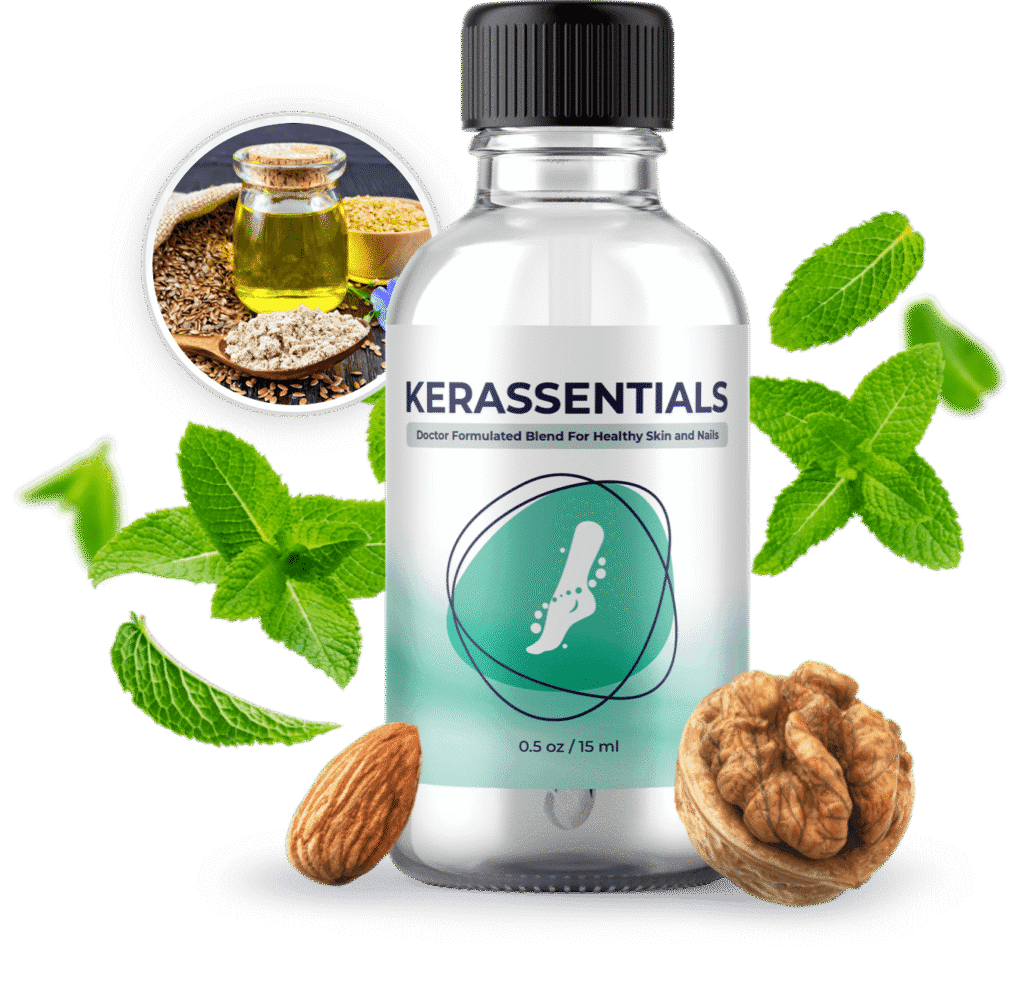Kerassentials Review: A Scientific Analysis of its Formula for Nail Health
Kerassentials is a liquid topical formula marketed heavily towards individuals seeking to support the health of their nails and surrounding skin. Its primary promise revolves around using a blend of natural oils and vitamins to combat the root causes of unhealthy nails, with a strong implication of targeting fungal infections. This analysis will dissect the formula ingredient by ingredient to determine if its scientific basis justifies its claims and cost.
APPROVED
Score: 7.0/10
Detailed Ingredient Analysis
The efficacy of any supplement lies in its formula. Kerassentials is a proprietary blend, meaning the exact concentration of each ingredient is not disclosed. While this is a significant drawback from an analytical perspective, we can still evaluate the scientific merit of each component.
The Antifungal Powerhouses
- Undecylenic Acid:
- What is it? A naturally occurring unsaturated fatty acid, often derived from castor oil.
- What is its function according to science? It is a well-established antifungal agent. The US Food and Drug Administration (FDA) has approved it for topical use in treating fungal infections like jock itch and athlete’s foot. It works by preventing the growth of fungus, particularly Candida albicans [1].
- Is the dosage effective? Commercial over-the-counter (OTC) products typically contain undecylenic acid in concentrations ranging from 10% to 25%. As Kerassentials uses a proprietary blend, the exact concentration is unknown. Its inclusion is positive, but its efficacy is dose-dependent.
- Tea Tree Oil (Melaleuca alternifolia):
- What is it? An essential oil distilled from the leaves of the Australian tea tree.
- What is its function according to science? Tea Tree Oil is one of the most researched essential oils for its broad-spectrum antimicrobial properties, including potent antifungal activity. Its primary active component, terpinen-4-ol, has been shown to be effective against various fungi that cause nail infections (onychomycosis) [2].
- Is the dosage effective? Studies showing positive effects often use concentrations from 5% to 100%. Without knowing the amount in the blend, we cannot confirm its potency within this formula.
- Lemongrass Oil:
- What is it? An essential oil derived from the lemongrass plant.
- What is its function according to science? It possesses notable antifungal properties, primarily due to its high citral content. Research suggests it can be effective against various strains of fungi and bacteria [3].
- Is the dosage effective? Its role is likely supportive to the primary antifungals. The required concentration for standalone efficacy is not well-established for nail application, and its amount in the formula is undisclosed.
The Supporting Cast: Skin and Nail Nourishers
- Lavender Oil:
- What is it? An essential oil from the lavender plant.
- What is its function according to science? While it exhibits some antifungal properties, it is generally considered less potent than Tea Tree Oil. Its main benefits here are likely its anti-inflammatory effects, its ability to soothe the skin, and its contribution to the product’s aroma [4].
- Organic Flaxseed Oil & Almond Oil:
- What are they? Carrier oils rich in fatty acids.
- What is their function according to science? These oils serve multiple purposes. They act as carrier agents, helping to dilute the potent essential oils and facilitate their absorption into the skin and nail. Secondly, they are excellent moisturizers. Flaxseed oil is rich in omega-3 (ALA), and almond oil is rich in oleic acid and vitamin E, both of which help fight inflammation, prevent skin dryness, and soften cuticles, creating a healthier environment for the nail to grow [5].
- DL-alpha-Tocopherol:
- What is it? A stable, synthetic form of Vitamin E.
- What is its function according to science? Vitamin E is a powerful antioxidant. When applied topically, it helps protect the skin from oxidative stress and damage. It supports skin barrier function and provides moisture. Its role here is purely for the health of the surrounding skin, not as a direct antifungal [6].
- Aloe Vera:
- What is it? A gel extracted from the leaves of the aloe plant.
- What is its function according to science? Known for its soothing, hydrating, and anti-inflammatory properties. It helps to calm irritated skin around the nail, which can often be red and damaged during a fungal infection. It also contains enzymes that can help exfoliate dry skin [7].
Efficacy Analysis: Can Kerassentials Work?
The formula demonstrates a logical and synergistic approach. It combines two well-regarded antifungal agents (Undecylenic Acid, Tea Tree Oil) with a supporting cast of ingredients designed to soothe and nourish the nail bed and surrounding skin. This is critical, as a fungal infection compromises the entire local environment.
However, the lack of transparency regarding ingredient concentrations is a major analytical weakness. The effectiveness of any antifungal treatment is fundamentally linked to its dose. While the ingredient selection is scientifically sound, we cannot confirm if the quantities are sufficient to produce a clinical effect comparable to standardized OTC products. The potential for efficacy exists, but it is not guaranteed.
Safety and Side Effects
As a topical product, Kerassentials has a generally high safety profile. The primary risks are:
- Skin Irritation: Essential oils, particularly Tea Tree Oil, can cause redness, itching, or irritation in sensitive individuals. A patch test on a small area of skin is strongly recommended before widespread use.
- Allergic Reactions: Individuals with known allergies to any of the listed ingredients (e.g., almonds, lavender) should avoid this product.
Contraindications (Who Should NOT Use This):
- Individuals with known allergies to any ingredient in the formula.
- Do not apply to open wounds, blisters, or broken skin without consulting a healthcare professional.
- For external use only. Keep away from eyes and mucous membranes.
- If a severe infection is suspected, consult a podiatrist or dermatologist for diagnosis and treatment.
Cost-Benefit Analysis
- Price: A single bottle of Kerassentials costs $69, with discounts for bulk purchases (e.g., 6 bottles for $49 each).
- Comparison: This places it at a premium price point. Standard OTC antifungal topical treatments (creams, lacquers) are typically available for $15-$30. While these OTC products may contain fewer ingredients, their active components are present in standardized, clinically-tested concentrations.
- Value: The value proposition of Kerassentials is its multi-ingredient, natural-oil-based formula and the convenience of a single product. However, the cost is significantly higher than established first-line treatments.
Manufacturer’s Reputation
The branding for Kerassentials appears to be primarily a direct-to-consumer operation.
- Transparency: The manufacturer’s identity is not prominently displayed, which is a common practice for products sold through dedicated sales pages. This lack of corporate transparency is a significant concern for our trust score.
- Third-Party Testing: The website states the product is made in an “FDA approved and GMP certified facility.” This is a standard for quality control in manufacturing but is not the same as third-party testing of the final product. Independent certificates of analysis (CoAs) verifying the purity and potency of the blend are not provided to consumers, which is a missed opportunity to build trust.
APPROVED
Score: 7.0/10
Recommendations
We Recommend Kerassentials For:
- Individuals seeking a natural, oil-based alternative to conventional creams or lacquers.
- Users who value the convenience of a multi-ingredient formula that addresses both fungal and skin health simultaneously.
- Those who have tried standard OTCs without success and are willing to invest at a premium price point for a different approach.
We DO NOT Recommend Kerassentials For:
- Consumers on a tight budget.
- Individuals who prefer clinically-proven treatments with precisely stated active ingredient concentrations.
- Users who prioritize brand transparency and the availability of third-party testing reports.
NutralabReviews Scoring Table
| Criterion | Score (1/10) | Weight | Weighted Score |
| Formula Efficacy | 7.0 | 40% | 2.8 |
| Safety & Purity | 9.0 | 30% | 2.7 |
| Cost-Benefit | 5.0 | 20% | 1.0 |
| Brand Trust | 5.0 | 10% | 0.4 |
| Final Score | 7.0 |
FAQ (Frequently Asked Questions)
1. How long does it take for Kerassentials to work? Results will vary significantly based on the severity of the condition, consistency of use, and individual body chemistry. Healthy nail growth is a slow process; visible improvement can take anywhere from several weeks to many months. Consistent, twice-daily application is crucial.
2. Is Kerassentials safe to use? For most people, it is safe for topical use. The main risk is skin irritation or an allergic reaction. We strongly advise performing a patch test before use and discontinuing if any irritation occurs. It is for external use only.
3. Can I buy Kerassentials on Amazon or at Walmart? Typically, products like Kerassentials are sold exclusively through their official website to control inventory, prevent counterfeits, and manage pricing. It is unlikely to be found in major retail stores or on Amazon.
4. What are the most important active ingredients in Kerassentials? Based on scientific evidence, the most powerful active ingredients for the product’s primary purpose are Undecylenic Acid and Tea Tree Oil, both of which have well-documented antifungal properties.


